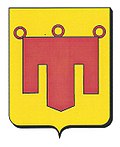List of the noble and patrician families named Gerner
Gerner is the name of nobility and patrician families who are not related in the German-speaking world. The variable modification in the family name Gerner resulted from the dropping of the ending t . The etymology derives the name via Gernot - Gernet zu Gernert and Gerner.
Gerner, Dutch nobility
In the 14th century, the Gern nobility can be proven in church weddings, they were acolytes. Gostuwe von Gerner, born around 1305, was the daughter of Albert von Gerner. Arnold von Almelo (von Gerner, von Eme) born around 1323. The coat of arms stands for the family that came from the Gernerhof near Oberissel, Gerner is a name of origin here. At present, the von Gerner nobility still exist in the Netherlands.
Glad, Rhenish nobility
Roberthus Gerner, loyal to the Prince of Orange, Nassau, Dillenburg, Limburg and governor of the Netherlands was ennobled in 1549. Coat of arms with ears of corn on a blue background, a pair of fish with a river and a hexagonal gold star.
Glad, Baden nobility
In 1590 a patrician family from Heidelsheim lived in Wimpfen. The Gerner were on May 18, 1640 by Emperor Ferdinand III. elevated to the nobility as count palatine. They called themselves Gerner von Lilienstein and were lords of the Schatthausen moated castle , owned the village of Wollenberg and two courtyards (houses) and gardens in Speyer.
Gerner, citizen of Main-Franconia
Between 1320 and 1331, as evidenced in documents, the family name of the Wertheim patrician family Gernot, called Irrmut, changed to the patronymic Gerner. A bourgeois family Gerner (t) then resident in the area of Klingenberg - Breuberg - Wertheim - Homburg am Main provided town clerks, mayors, students, pastors and mill owners in the places until the 18th century. A migration to Baden ( Amorbach ) with their liege lords von Kottwitz , von Collenberg and von Fechenbach is likely.
Glad, Baden patricians and citizens
- Gerner bought Sindolsheim Castle from Freiherr Kraft von Erffa in 1731 , it was the former property of Rüdt von Collenberg .
- Gerner, middle class family in Adelsheim (mayor in the 19th and 20th centuries). Coat of arms, Adolf Gerner (1872–1914), mayor and Friedrich Gerner (1906–1989), mayor from 1948 to 1973, Federal Cross of Merit. Another branch has been based in Adelsheim - Wemmershof since 1683 .
literature
To Baden-Württemberg nobility, Gerner
- Adolf Pfisterer: Chronicle of the community Schatthausen. 1955.
- Günther Groh: The staff of the Reich Chamber of Commerce in Speyer. Part I: Family Relationships. P. 110.
- Klaus Gaßner: Schatthausen. A bailiff's rule in the early modern period. University Press C. Winter, Heidelberg 1994.
- Wappenbuch, Alter Siebmacher. Part IV. Plate ennobled. Plate 70.
See also
- Gernert coat of arms: List of noble and patrician families named Gernert
- Gernet coat of arms: List of the noble and patrician families named Gernet
- Görner coat of arms: List of noble and patrician families named Görner
- Gerner (family name)
Individual evidence
- ↑ armoiries ... de families nobles et patriciennes des Pays-Bas . In: Centraal Bureau voor Genealogie (Ed.): CBG, GHS 50A08 . Collection de 2266 armoires, Wapenkaart Overijssel (1-9-1-1), or 74.





